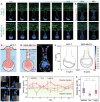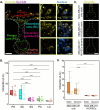Intravasation-On-µDevice (INVADE): Engineering Dynamic Vascular Interfaces to Study Cancer Cell Intravasation
- PMID: 40223399
- PMCID: PMC12232236
- DOI: 10.1002/adma.202501466
Intravasation-On-µDevice (INVADE): Engineering Dynamic Vascular Interfaces to Study Cancer Cell Intravasation
Abstract
Cancer metastasis begins with intravasation, where cancer cells enter blood vessels through complex interactions with the endothelial barrier. Understanding this process remains challenging due to the lack of physiologically relevant models. Here, INVADE (Intravasation-on-µDevice), a biomimetic microfluidic platform, is presented, enabling high-throughput analysis of cancer cell intravasation under controlled conditions. This engineered platform integrates 23 parallel niche chambers with an endothelialized channel, providing both precise microenvironmental control and optical accessibility for real-time visualization. Using this platform, distinct intravasation mechanisms are uncovered: MCF-7 cells exhibit collective invasion, while MDA-MB-231 cells demonstrate an interactive mode with three functionally distinct subpopulations. A previously unknown epithelial-mesenchymal transition (EMT) and mesenchymal-epithelial transition (MET) switch is We discovered during intravasation, where MDA-MB-231 cells initially increase Vimentin expression before undergoing a 2.3 fold decrease over 96 h alongside a 1.5 fold increase in epithelial cell adhesion molecule (EpCAM). Remarkably, endothelial cells directly suppress cancer cell mesenchymal properties, as evidenced by a 4.6 fold reduction in Vimentin expression compared to mono-cultures. Additionally, bilateral cancer-endothelial interactions are revealed, aggressive cancer cells induce significant intercellular adhesion molecule-1 (ICAM-1) upregulation in endothelium. The INVADE platform represents an engineering advancement for studying complex cell-cell interactions with implications for understanding metastatic mechanisms.
Keywords: cancer metastasis; endothelium; epithelial‐mesenchymal transition; intravasation, microfluidics; vimentin.
© 2025 The Author(s). Advanced Materials published by Wiley‐VCH GmbH.
Conflict of interest statement
The authors declare no conflict of interest.
Figures








Similar articles
-
Lung cancer intravasation-on-a-chip: Visualization and machine learning-assisted automatic quantification.Bioact Mater. 2025 Jun 27;51:858-875. doi: 10.1016/j.bioactmat.2025.06.028. eCollection 2025 Sep. Bioact Mater. 2025. PMID: 40678259 Free PMC article.
-
Functional Implications of the Dynamic Regulation of EpCAM during Epithelial-to-Mesenchymal Transition.Biomolecules. 2021 Jun 29;11(7):956. doi: 10.3390/biom11070956. Biomolecules. 2021. PMID: 34209658 Free PMC article. Review.
-
Dissecting Exosomal-Tumoral-Vascular Interactions of Single Tumor Cells and Clusters Using a Tumoral-Transendothelial Migration Chip.ACS Nano. 2025 Jul 8;19(26):23680-23692. doi: 10.1021/acsnano.5c02557. Epub 2025 Jun 24. ACS Nano. 2025. PMID: 40556461
-
TGF-β1 exposure induces epithelial to mesenchymal transition both in CSCs and non-CSCs of the A549 cell line, leading to an increase of migration ability in the CD133+ A549 cell fraction.Cell Death Dis. 2013 May 2;4(5):e620. doi: 10.1038/cddis.2013.144. Cell Death Dis. 2013. PMID: 23640462 Free PMC article.
-
The Epithelial-to-Mesenchymal Transition-Like Process in Glioblastoma: An Updated Systematic Review and In Silico Investigation.Med Res Rev. 2017 Mar;37(2):271-313. doi: 10.1002/med.21408. Epub 2016 Sep 12. Med Res Rev. 2017. PMID: 27617697
References
-
- Chaffer C. L., Weinberg R. A., Science 2011, 331, 1559. - PubMed
-
- de Visser K. E., Joyce J. A., Cancer Cell 2023, 41, 374. - PubMed
-
- Reymond N., Agua d′ B. B., Ridley A. J., Nat. Rev. Cancer 2013, 13, 858. - PubMed
-
- Zhang Y., Jiang F., Zhao Y. C., Cho A. N., Fang G., Cox C. D., Zreiqat H., Lu Z. F., Lu H., Ju L. A., Biomed. Mater. 2023, 18, 055008. - PubMed
MeSH terms
Substances
Grants and funding
- H22/98586/NSW Cardiovascular Capacity Building Program
- DP240102315/Australian Research Council
- DP240101768/Australian Research Council
- FT230100249/Australian Research Council
- 105863/WT_/Wellcome Trust/United Kingdom
- MRF2023977/MRFF Cardiovascular Health Mission Grants
- 391-FY2023/Tour de Cure Pioneering Research
- 106979/National Heart Foundation Vanguard
- 2022SF176/Snow Medical Research Foundation
- 030GJHZ2023098FN/the International Partnership Program of Chinese Academy of Sciences
- 030GJHZ2024103MI/the International Partnership Program of Chinese Academy of Sciences
- 105863/WT_/Wellcome Trust/United Kingdom
LinkOut - more resources
Full Text Sources
Miscellaneous

